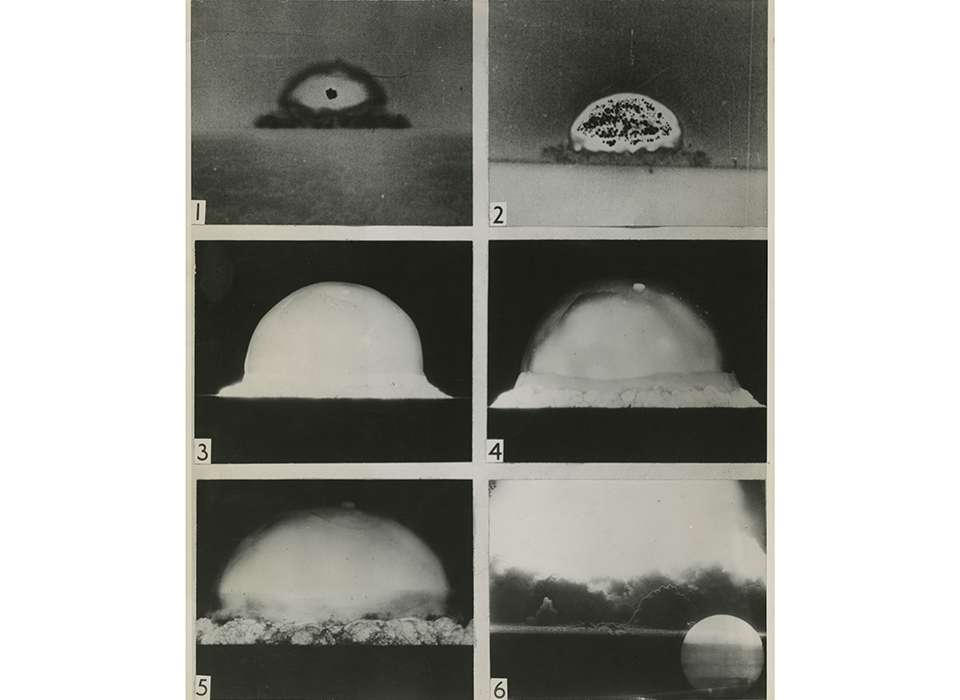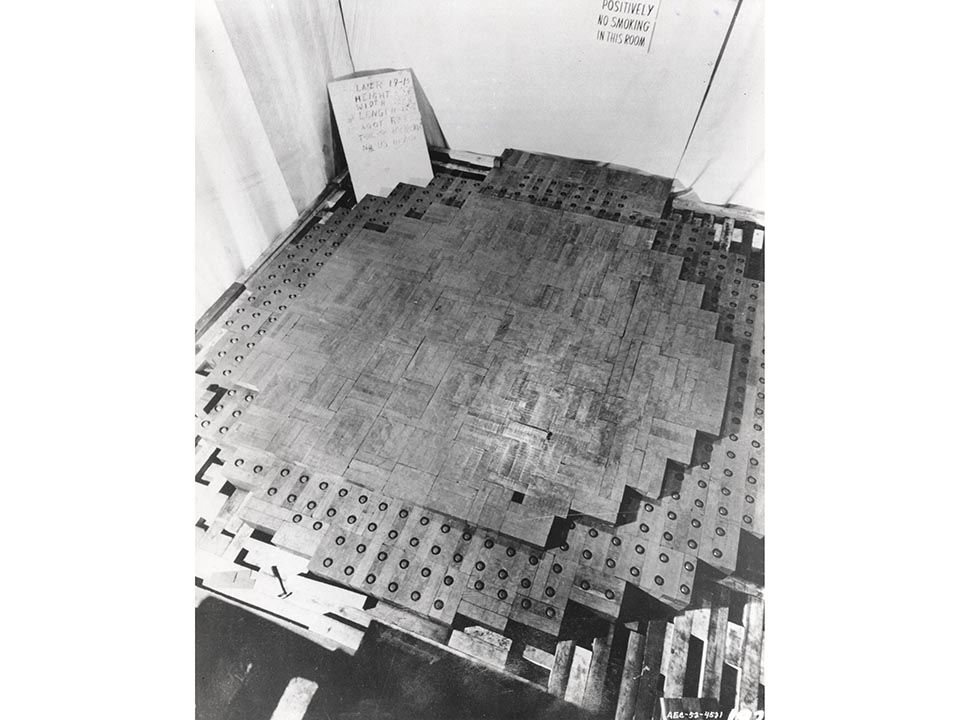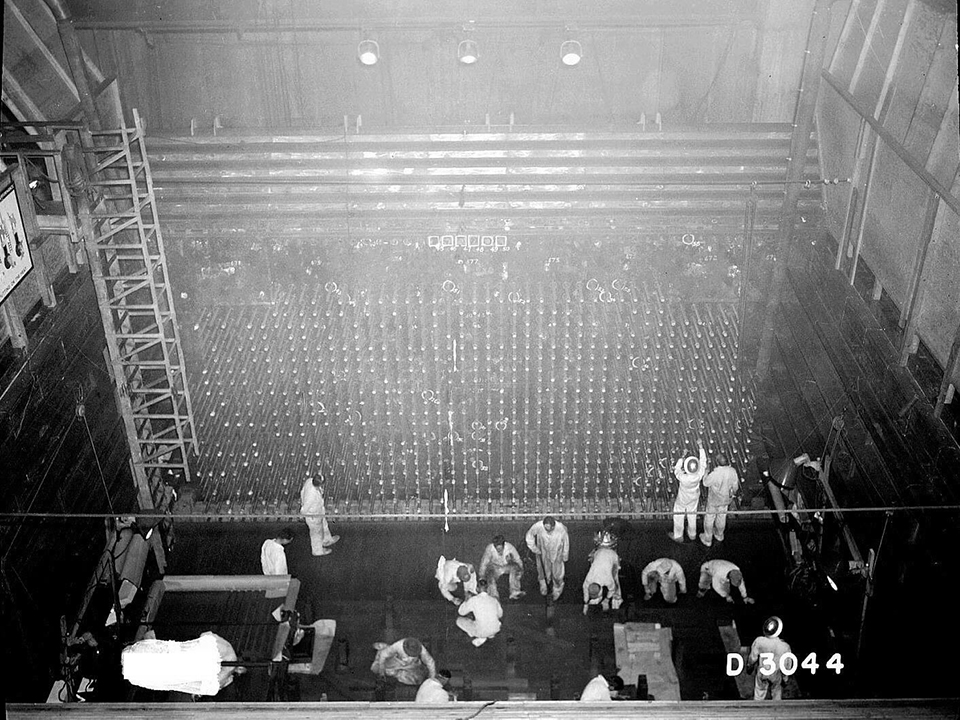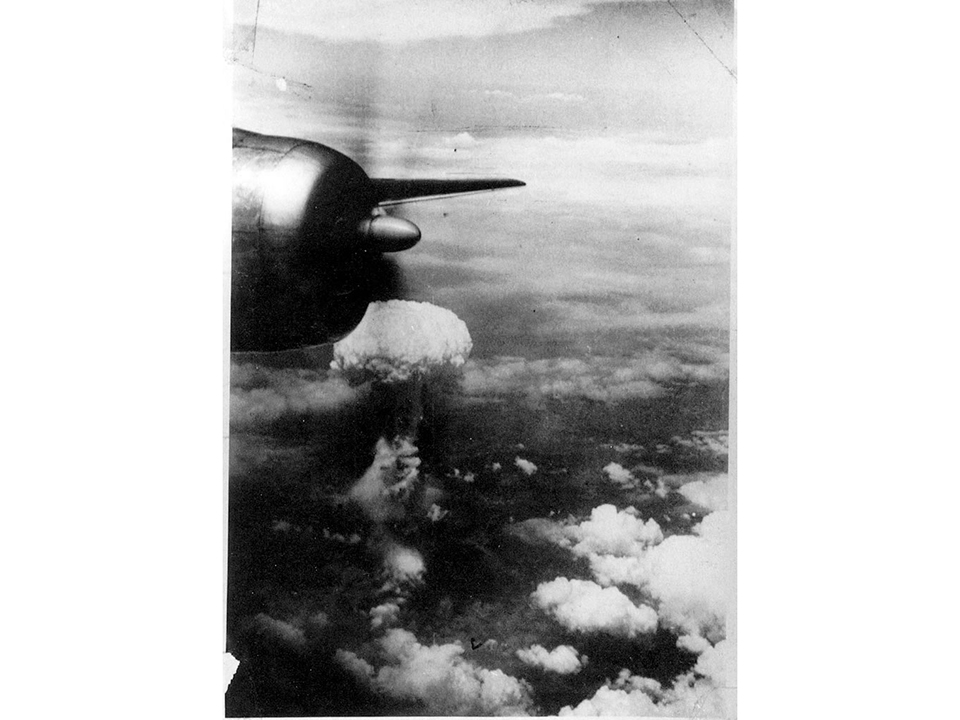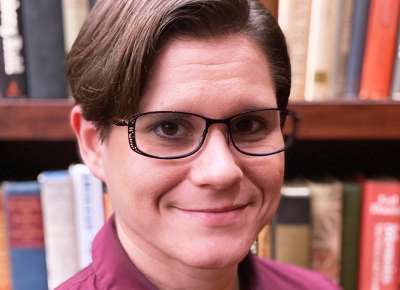Top Photo: Expanding explosion from an atomic bomb test, New Mexico 16-Jul-45. The National WWII Museum, 2012.019.741
Achieving the monumental goal of splitting the nucleus of an atom, known as nuclear fission, came through the development of scientific discoveries that stretched over several centuries. Beginning in 1789, when German scientist Martin Klaproth discovered the dense, metallic element he called uranium, exploration of atomic energy and radiation came to fascinate scientific minds. As Marie Curie was conducting her groundbreaking research on uranium in the late nineteenth century, she found that the element was naturally radioactive. Curie created the term “radioactive” to describe the emission of electromagnetic particles from disintegrating atoms. Curie’s discovery of radioactivity in elements forever changed the nature of atomic science. Building from this research, British physicist Ernest Rutherford in 1911 formulated a model of the atom in which low-mass electrons orbited a charged nucleus that contained the bulk of the atom’s mass.
GERMAN DISCOVERY OF FISSION
The 1930s saw further development in the field. Hungarian-German physicist Leo Szilard conceived the possibility of self-sustaining nuclear fission reactions, or a nuclear chain reaction, in 1933. The following year, Italian physicist Enrico Fermi unknowingly split neutrons within uranium while conducting his own experiments. On the heels of these developments, Austrian-Swedish physicist Lise Meitner, working with German chemist Otto Hahn, was among the first to achieve the successful fission of uranium. However, the antisemitism of the Nazi party forced Meitner, who was Jewish, to flee and settle in Sweden. While in Sweden, Meitner identified and named the process of nuclear fission.
Meitner’s findings became a tipping point in the development of nuclear weapons, but as the world once more moved into war, it was the Germans who held the potential key to nuclear power. While Hahn chose to remain in Germany and continued to develop his research throughout World War II, scientists across Europe steadily fled. Szilard, a Jewish man, migrated to the United States in 1938 to avoid persecution. Fermi and his wife, Laura Capon, also left Europe at the end of 1938 to escape growing Fascism in Italy. Capon, who was also Jewish, traveled with Fermi to New York City where both applied for permanent residency.
THE UNITED STATES TAKES ACTION
When news of Hahn and Meitner’s discovery of fission reached Szilard in his New York City home in early 1939, Szilard began work to confirm their findings. Szilard found help in collaborator Walter Zinn, and together they recreated Hahn’s experiment. Recognizing the significance of that moment, Szilard stated, “That night, there was very little doubt in my mind that the world was headed for grief.” Szilard began to work with Fermi to construct a nuclear reactor at Columbia University, but as they did so, Szilard feared that scientists in Germany, who were aiding the Nazi war effort, were similarly constructing their own reactors.
In July 1939, Szilard contacted the prominent Jewish German theoretical physicist Albert Einstein at his home on Long Island, New York, to discuss German advances in nuclear development. Together, Szilard and Einstein drafted a letter to US President Franklin D. Roosevelt. In the letter, dated August 2, 1939, the warning was clear: “This new phenomenon would also lead to the construction of bombs, and it is conceivable—though much less certain—that extremely powerful bombs of a new type may thus be constructed.” The letter did not reach Roosevelt until October, but once he learned of the potential risks presented by nuclear weaponry, he responded by forming the Advisory Committee on Uranium, which held its first meeting on October 21, 1939.
THE MANHATTAN PROJECT
Although formed in 1939, the Advisory Committee on Uranium moved slowly at first. However, Japan’s attack on Pearl Harbor on December 7, 1941, pushed the Committee into action. With the United States formally at war, the question of uranium development and the potential construction of an atomic bomb gained renewed interest. This interest rose even higher as a report issued by British scientists in March 1941 confirmed the possibility of building a uranium-based bomb, giving American scientists the validation they sought. In spite of this enthusiasm, the limitation of resources quickly became evident and prompted committee leaders to turn to the military for help.
As the United States began its island-hopping campaign in the Pacific, the Army Corps of Engineers took over the effort to produce atomic weaponry on the Home Front. On August 13, 1942, the Army Corps created the Manhattan Engineer District, named for the location of its offices in New York City. The following month, on September 17, Colonel Leslie R. Groves was appointed to head the project and received a promotion to Brigadier General. Within two days of his appointment, Groves made quick decisions to move the project forward, selecting three primary sites for the manufacture of an atomic bomb.
Groves first selected Oak Ridge, Tennessee, as the site for uranium enrichment. Also among the primary project sites was Los Alamos, New Mexico. Designated “Project Y,” Los Alamos was the site of the Manhattan Project’s weapons research laboratory. This Los Alamos site would become the location for the construction of the atomic bombs. The last primary site Groves selected was Hanford, Washington, which he designated to produce plutonium from the uranium isotope U-238. Though plutonium is not a naturally occurring element, scientists discovered its production within uranium reactors. Plutonium proved to be a more radioactive metal and had a higher possibility of achieving nuclear fission.
As Groves made these moves, a breakthrough in nuclear research beneath the squash courts at the University of Chicago created a model for the future production of atomic weapons.
Early in 1942, Fermi and Szilard, who had been working to build a reactor at the University of Columbia, moved their effort to Chicago. After construction was complete, on December 2 of that year, the scientists began removing the cadmium control rods from the uranium pile. Following the removal of the final control rod, the pile went critical. The resulting nuclear reaction became self-sustaining and continued at an increasing pace for a few minutes until Fermi ordered the reactor shut off. Although the reaction only produced enough energy to power a light bulb, this moment marked the first instance in history of a self-sustaining nuclear reaction. The event also gave nuclear scientists a model for the production of large amounts of plutonium, which would eventually become the basis of the B Reactor built at Hanford.
After receiving formal approval from President Roosevelt on December 28, 1942, the Manhattan Project developed into a massive undertaking that spread across the United States. With over 30 project sites and over 100,000 workers, the Manhattan Project came to cost approximately $2.2 billion. Even though encompassing such a massive scale, the project largely remained a secret, and many of the people working on the construction of the atomic bomb did not fully know the purpose behind their jobs. Following Fermi’s successful experiment in Chicago, there appeared to be two possible paths toward building atomic bombs: uranium and plutonium. The Manhattan Project built both kinds of bombs, ultimately resulting in the construction of Little Boy, a gun-method uranium bomb, and Fat Man, an implosion-method plutonium bomb.
The responsibility of bringing these bombs into existence fell to the man Groves selected to head the secret weapons laboratory at Los Alamos: J. Robert Oppenheimer. A theoretical physicist and professor of physics at the University of California, Berkeley, Oppenheimer became involved early in the scientific research that ultimately led to the Manhattan Project. Under Oppenheimer’s direction, Manhattan Project workers constructed a plutonium bomb.
The plutonium bomb relied upon the implosion of the reactive plutonium rather than on the piercing of the plutonium with a bullet, which was common in gun-method bombs and which worked better with uranium. While the gun-method was a more familiar method conceptually to its creators, the implosion-method was not. Due to the unprecedented nature of such a bomb, Oppenheimer felt a test was necessary. Groves initially hesitated because plutonium was both expensive and rare. However, Groves relented and approved moving forward with a test.
"We waited until the blast had passed, walked out of the shelter and then it was entirely solemn. We knew the world would not be the same. A few people laughed, a few people cried. Most people were silent."
J. Robert Oppenheimer
THE TRINITY TEST
Inspired by the seventeenth-century poet, John Donne, Oppenheimer came to call the test “Trinity.” Oppenheimer had been reading Donne’s Holy Sonnets before the test and found inspiration in the line from “Sonnet XIV,” which opens with the line, “Batter my heart, three-person'd God.” The test took place at Alamogordo, New Mexico, rather than at Los Alamos. Hundreds of Manhattan Project workers moved in to prepare the Alamogordo site which was located 200 miles south of the Project Y site. The test bomb, nicknamed Gadget, contained 13 pounds of plutonium, as well as the implosion-method of detonation. Using a steel tower, scientists hoisted and suspended Gadget 100 feet into the air, and at 5:29 a.m. on July 16, 1945, the Trinity Test began. The test proved far more successful than Oppenheimer anticipated. He had expected an explosion equivalent to .3 kilotons of TNT; instead, the resulting blast equated to roughly 21 kilotons of TNT.
The flash from the bomb was so bright that it temporarily blinded observers standing 10,000 yards away. The heat from the bomb was so intense that it evaporated the steel tower, left a crater five feet deep by 30 feet wide, and melted the sand in the area, creating a mildly radioactive green glass called “trinitite.” Upon witnessing the blast, Oppenheimer famously uttered a line from the Bhagavad Gita, “Now I am become Death, the destroyer of worlds.”
CONCLUSION
The success of the Trinity Test exceeded the expectations of Groves and most of the scientists involved in the Manhattan Project. The day after the test, Roosevelt’s successor, President Harry Truman, traveled to the Potsdam Conference where he received word of the Trinity Test’s success. Truman used the results as leverage to demand Japan’s unconditional surrender, which Japanese officials opted to ignore. The discovery and harnessing of atomic energy not only served to bring World War II to a rapid and fiery end, but it also placed the United States in a position of global power not held by any other nation following the war’s end. From the race to keep such power out of Nazi hands and to the use of atomic bombs on Japan to end the war, the Manhattan Project pushed humanity across the threshold into a new atomic age that forever altered the nature of conflict and the fear of global warfare.
"Now I am become death, the destroyer of worlds."
J. ROBERT OPPENHEIMER REFERENCING A VERSE FROM THE BHAGAVAD GITA.
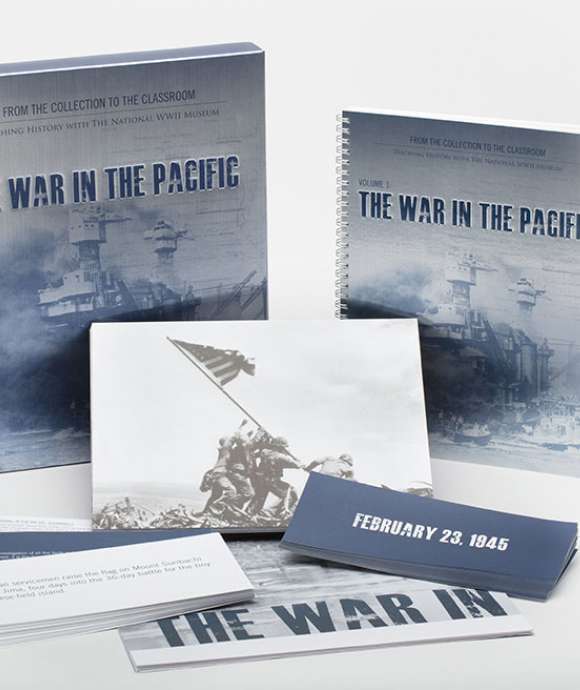
Like this article? Read more in our online classroom.
From the Collection to the Classroom: Teaching History with The National WWII Museum.
Kristen D. Burton, PhD
Kristen D. Burton, PhD, is a former Teacher Programs and Curriculum Specialist at The National WWII Museum.
Cite this article:
MLA Citation:
APA Citation:
Chicago Style Citation:
